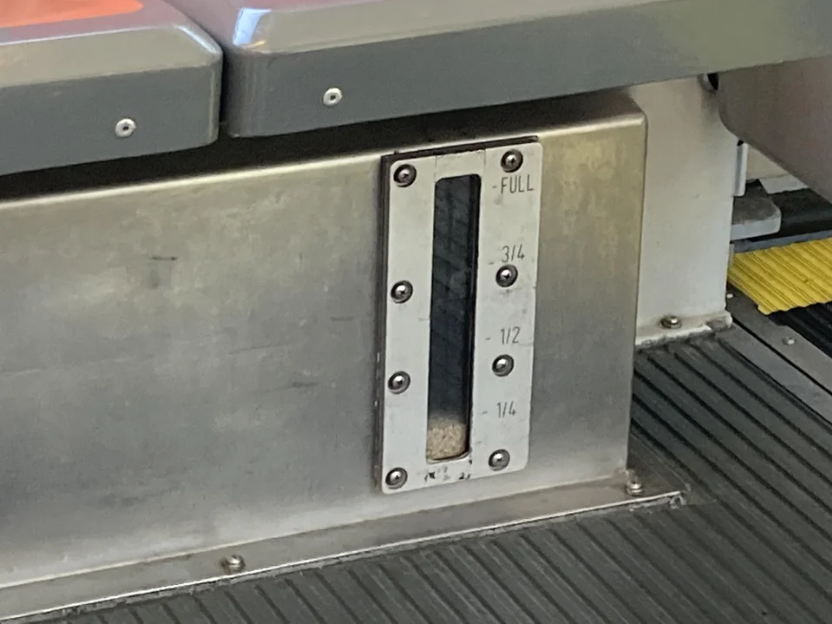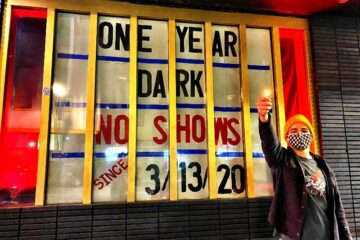What are Those Boxes Under MUNI Seats For?

A MUNI mystery box. Look under your chaaair! Photo usage granted by Reddit user @tarojelly
Ever wonder why there’s a metal box in the way when you try to tuck your feet under your seat? It’s the one beneath those side-facing, longitudinal seats. There’s a window on the front-right panel, a gauge to assess the volume of its content from outside. When I find myself in the triple-seaters, I bang the heel of my shoe against the metal. Sometimes it sounds hollow, others the box feels full.
The mystery boxes aboard MUNI’s rail-bound vehicles don’t contain any fuel and they do not house a sophisticated braking system. These little tanks are filled with sand.
A simple solution…
MUNI’s diverse fleet of vehicles include three rail options. Catch one of the city’s heritage streetcars on Market Street’s F-Market/Wharves line. Visit the Castro or ride to the Ferry Building and beyond, to Fisherman’s Wharf if you’re a glutton for punishment. If so, hop a cable car from the Wharf and take it up and over to the foot of Powell Street. Us San Franciscan chaff however generally stick to light-rail, like the Sunset-serving N-Judah or Dolores Park pipeline J-Church.
All of these rail-bound transit modes have a box like this aboard. Each is full of sand. A valve positioned in front of the wheel pours a stream of sand on the rail, boosting traction. Steel-against-steel can yield insufficient friction at the feet of certain hills, and at regular grades when it rains. The sand, shipped in from Monterey at 17¢ a pound in 2017 dollars, helps arrest a train’s excess motion. Without it, expect the train to overshoot its stop and squeak an awful lot trying not to.
…with messy consequences.
Sand piles accumulate and weather to pits at intersections where rail and cyclist often intersect. It often proves treacherous for those wishing to roll on through unharmed. Unlike wet leaves, the bane of every rider, sand is not as infamously dangerous. The instinct to brake redistributes the load to the front end of your bike, which could result in a crash. Another exciting way to fall on sand or gravel is to lean into a turn. Your back wheel might fishtail, getting you up close and personal with the pavement.
As if the tracks weren’t hazardous enough. “I find the piles of sand add a fun, additional layer of cyclist danger to the absolute clusterfuck that is the Duboce and Steiner intersection,” wrote Jessica Saia for The Bold Italic. “The city’s historic cable cars dumped 50 tons of sand onto the street [in 2013],” said Joe Eskanazi for the now-defunct SFWeekly. “That’s four times as much…as the jaunty Italian-made streetcars spat out, but only half as much as the light-rail vehicles housed at MUNI’s biggest car barn.
“Alas,” he added, “the sand is not reusable. All told, 256 tons of sand was used [in 2013] in preventing trains from running into one another.”

Howdy! My name is Katy Atchison and I'm an Associate Editor for Broke-Ass Stuart.
I want to take the time to say thank you for supporting independent news media by reading BrokeAssstuart.com. Supporting independent news sources like Broke-Ass Stuart is vital to supporting our community because it amplifies the voices of a wide variety of diverse opinions. You also help support small businesses and local artists by sharing stories from Broke-Ass Stuart.
Because you're one of our supporters, I wanted to send over a pro-tip.
Our bi-weekly newsletter is a great way to get round ups of Broke-Ass Stuart stories, learn about new businesses in The Bay Area, find out about fun local events and be first in line for giveaways.
If you’d like to get our newsletter, signup right here, it takes 5 seconds.




